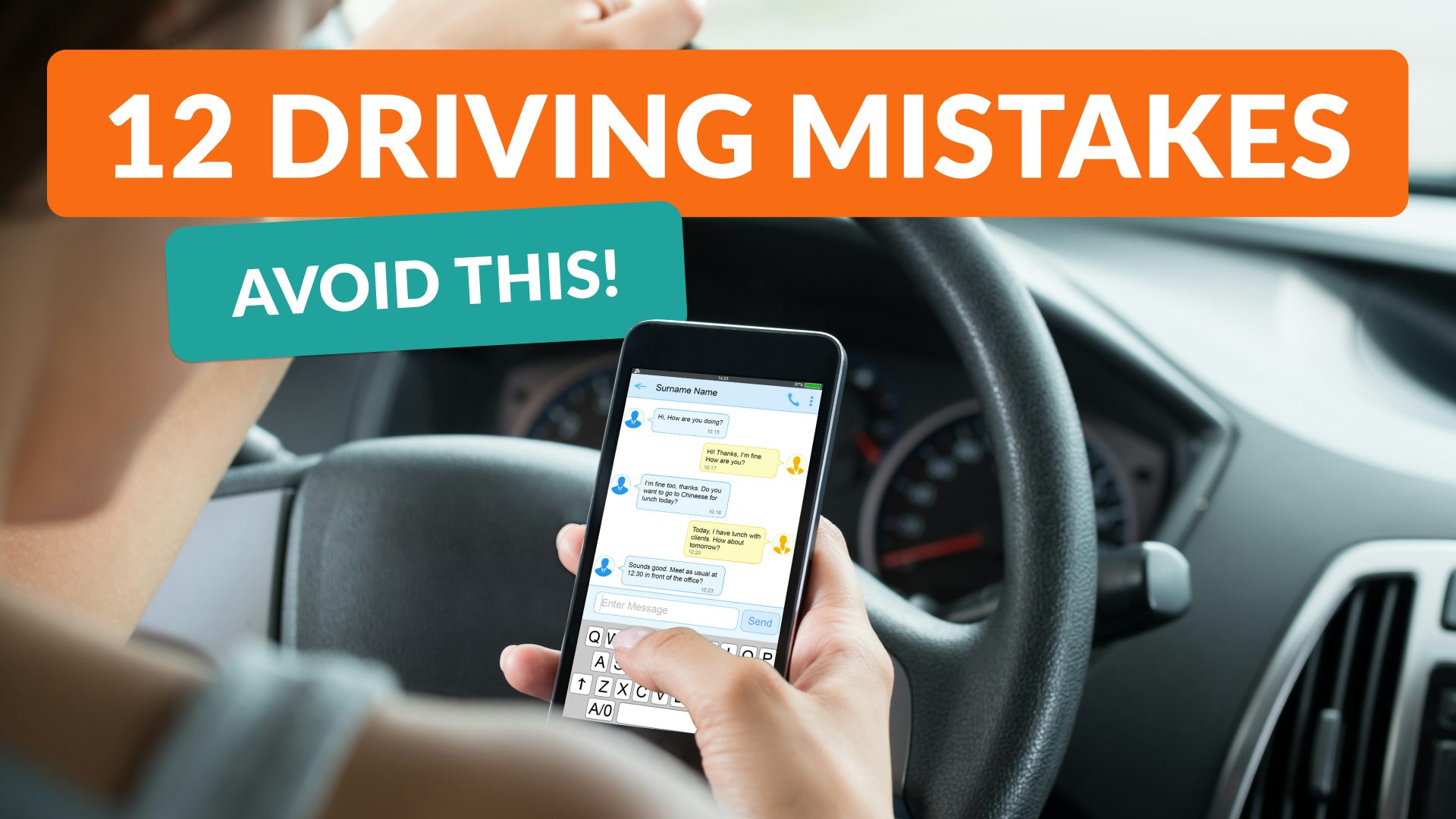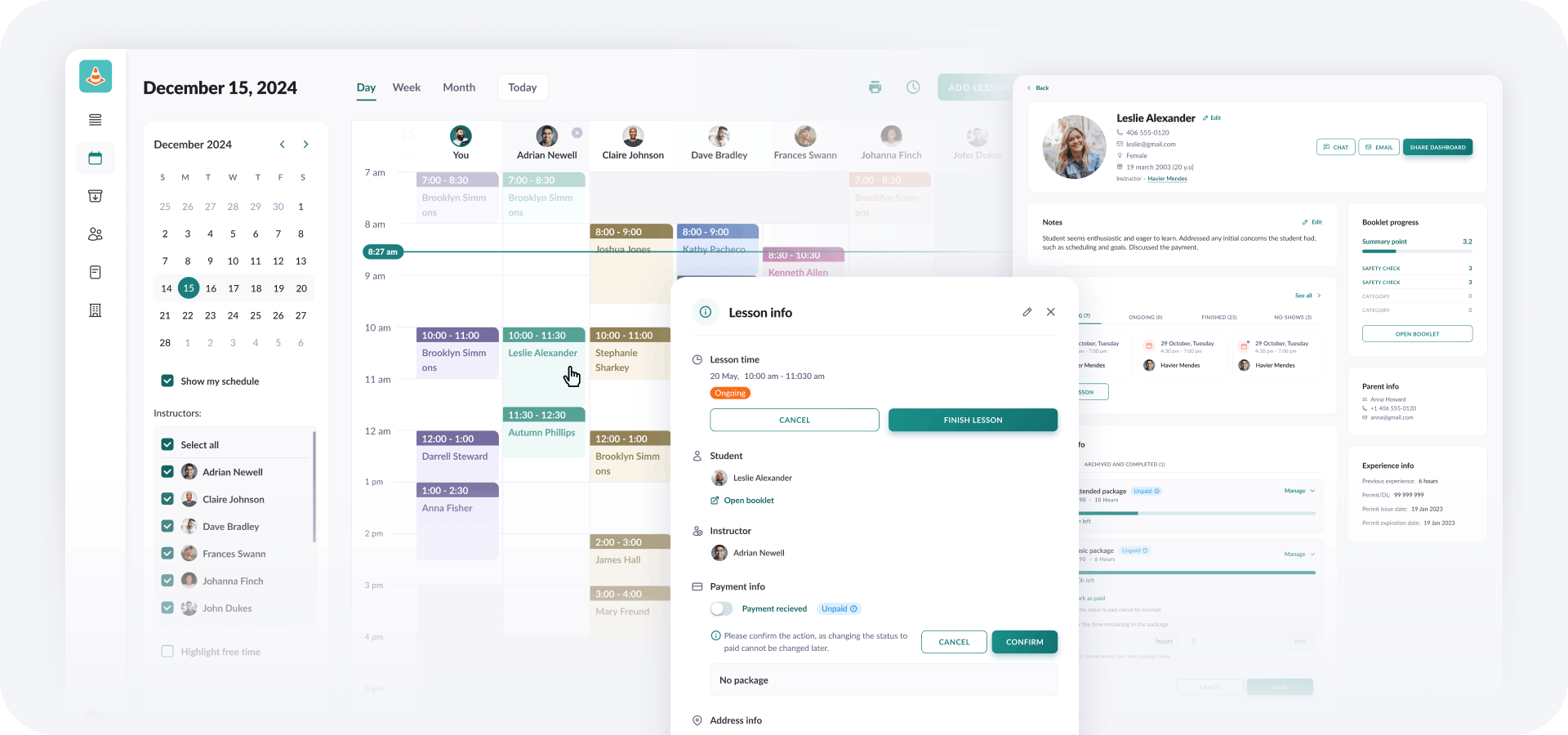
12 Common Driving Mistakes Every New Driver Should Avoid
This article covers the following mistakes and how to fix them:
- Not Paying Attention to Road Signs
- Speeding Up and Slowing Down a Lot
- Speeding Through Yellow Lights
- Taking off Too Soon After Green Light
- Braking Too Hard
- Not Judging Spaces Well
- Not Checking Blind Spots
- Following Too Closely
- Forgetting to Signal
- Switching Lanes at an Intersection
- Forgetting to Turn Off High Beams
- Paying Too Much Attention to Your Phone
1. Not Paying Attention to Road Signs
When you’re new to driving, there’s so much to focus on – the pedals, steering wheel, other cars, pedestrians. It’s easy to overlook road signs. However, they are crucial for safe driving as they inform you about speed limits, road conditions, and upcoming hazards.
Advice
A good practice is to narrate your actions as you drive, like saying aloud, “Speed limit sign, 30 mph” or “Stop sign ahead.” This habit will help you stay aware of the signs and their instructions.
2. Changing Speed a Lot
You might find it difficult to judge how much to press the accelerator or the brake, leading to a jerky ride. Also, keeping a constant speed in traffic seems tough when you’re constantly worried about maintaining a safe distance.
Advice
Spend time practicing in a low-traffic area. Focus on pressing the gas and brake pedals smoothly. Also, keep an eye on the speedometer and try to maintain a steady speed. Remember, it’s okay to drive a bit slower if you’re not confident in speeding up.
3. Speeding Through Yellow Lights
You might think a yellow light means ‘hurry up and get through the intersection,’ but it actually means ‘stop if it’s safe to do so.’ The urge to keep moving with traffic often overrides caution.
Advice
Start viewing yellow lights as a warning to stop, not as a cue to speed up. If you see the light turn yellow and you’re at a safe distance to stop, do so. Practice this approach consistently.
4. Taking off Too Soon After Green Light
In the eagerness to keep traffic flowing or under pressure from other drivers, you might start moving as soon as the light turns green. However, rushing can lead to accidents, especially if other drivers are running the red light from the other direction.
Advice
When the light turns green, take a moment to look both ways to ensure the cross traffic has stopped. Count to three if it helps. This brief pause can make a big difference in safety.
5. Braking Too Hard
Finding the right balance on the brake pedal takes practice. As a beginner, you might either press too lightly, not slowing down enough, or press too hard, causing an uncomfortable or sudden stop. It’s especially common when you’re anxious or in a rush.
Advice
Practice by starting to press the brake pedal earlier than you think you need to, allowing more time and distance to slow down smoothly. Imagine there’s a cup of coffee on the dashboard, and you don’t want to spill it. This visualization helps in achieving smoother stops.
6. Not Judging Spaces Well
When you’re new behind the wheel, the car’s dimensions don’t feel instinctive yet. Parking in a tight spot or squeezing through narrow gaps can feel daunting because you aren’t used to the car’s size.
Advice
Practice in a safe, open area like an empty parking lot. Set up cones or use existing lines to simulate parking spaces and narrow paths. With regular practice, you’ll develop a sense of the car’s size and how to maneuver it.
7. Not Checking Blind Spots
As a new driver, you rely heavily on mirrors to understand your surroundings. However, mirrors don’t show everything. The areas just outside of your peripheral vision are known as blind spots, and they can hide other vehicles, making it easy to miss seeing something important when changing lanes.
Advice
Always perform a shoulder check by briefly turning your head to look over your shoulder before changing lanes or merging. Do this in addition to checking your mirrors. This simple move can prevent many accidents.
8. Following Too Closely
Following the car ahead too closely or tailgating increases the risk of rear-end collisions, especially if the front car stops suddenly. Beginners might misjudge stopping distances or not pay attention to their following distances in traffic.
Advice
A good rule is the “three-second rule”: when the car ahead passes a fixed point, like a sign, it should take you at least three seconds to reach the same point. Increase this distance in bad weather or at higher speeds. This gives you enough time to react and stop if necessary.
9. Forgetting to Signal
Signaling can easily slip your mind, especially when you’re focusing on so many other aspects of driving. For beginners, remembering to signal every time you turn or change lanes isn’t yet a habit, so it’s unintentionally forgotten.
Advice
Start building the habit by consciously reminding yourself to signal every time you make any turn or lane change. You can even verbalize it while driving, saying “signal” out loud as a reminder. With practice, it will become a natural part of your routine.
10. Switching Lanes at an Intersection
New drivers might try changing lanes at intersections, usually if they’re in the wrong lane or need to make a last-minute turn. This is risky because intersections are complex areas with multiple vehicles moving in different directions.
Advice
Always plan your route and lane choices in advance to avoid last-minute lane changes. If you find yourself in the wrong lane, keep going safely in the same direction and look for a safe way to circle back.
11. Forgetting to Turn Off High Beams
High beams are used less frequently, so you might forget to turn them off. This can be dangerous as it blinds other drivers.
Advice
Get into the habit of checking your beam indicator on the dashboard regularly, especially when another car is approaching or ahead of you. Switch to low beams well in advance. Practice switching between high and low beams in different driving situations.
12. Paying Too Much Attention to Your Phone
The habit of constantly checking the phone is hard to break, but it’s very dangerous and accounts for thousands of deaths every year. It is also illegal in all 50 states.
Advice
Keep your phone out of reach while driving, like in the backseat or glove compartment. Turn on ‘Do Not Disturb’ mode or a driving mode app that restricts calls and messages while driving. Remember that any phone activity can wait until you reach your destination or stop.
Overcome Beginner Driving Challenges with Zutobi
Our app blends theory material with a practical behind-the-wheel video course, offering clear guidance for every driving maneuver. From speed management to safe driving practices, Zutobi equips you with the knowledge and skills you need. Sign up for Zutobi now and take a confident step towards proficient driving.

550+ exam-like questions
All you need to ace your test
Perfect for first-timers, renewals and senior citizens
Recommended articles
Ace your DMV test, guaranteed
Want to Be the Top School in Your Area?
- Simple & automated admin
- More time for teaching
- #1 learning materials for students


